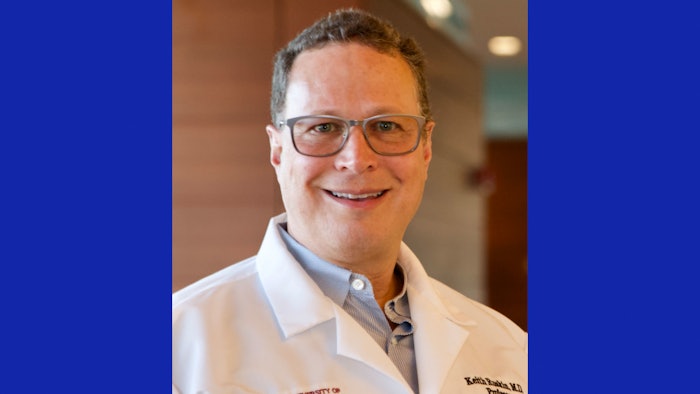High-altitude alert
What to do during an in-flight emergency.

RCL405 – Management of In-Flight Medical Emergencies
Tuesday, October 17 | 12:30-1:30 p.m.
South 203/204
Airline travel can be stressful. With packed seating, unruly passengers, and the rare mechanical problem, it’s enough to make you sick – literally and figuratively. Not surprisingly, as an anesthesiologist, you may have a heightened sense of awareness and duty for in-flight medical emergencies.
According to Keith Ruskin, MD, FAsMA, FRAeS, FASA, Professor of Anesthesiology at the University of Chicago, there’s good reason you may encounter such a scenario. Many factors, including psychological stress, circadian misalignment, and preexisting illness, can cause a passenger to become sick while flying. Similarly, the cabin of a pressurized aircraft exposes passengers and crew to mild hypoxia. What to do in such an encounter is the focus of this afternoon’s session, “Management of In-Flight Medical Emergencies,” led by Dr. Ruskin. He also is President of the Aerospace Human Factors Association and Chair of the Aerospace Medical Association’s (AsMA) Aerospace Human Performance Committee.
“There are several factors that work together to cause medical emergencies. First, the cabin is pressurized during flight, but not to sea level. Depending on the aircraft and cruising altitude, the air pressure in the cabin is somewhere between 6,000 and 8,000 feet. That means that even though you're flying from New York to San Francisco, during the flight you’re at the equivalent of Aspen,” Dr. Ruskin said. “That means that everyone on board the flight has some degree of hypoxia. Most people tolerate that reasonably well, but if you’ve got preexisting lung disease, that decrease in pressure may be just enough to tip you over.”
In fact, this affects the ability to provide CPR, he said.
“We did a study and found that even healthy, young volunteers couldn’t do CPR as well when we asked them to do it at the equivalent of 8,000 feet,” Dr. Ruskin said. “Secondly, people are being asked to sit for long periods of time in a cramped environment with limited access to food and water. We’re also seeing complications of that.”
Additionally, Dr. Ruskin said gas-containing spaces expand during flight, which is why our ears “pop.” Flying with a sinus infection can cause severe pain. Likewise, anything else with gas in a confined space can expand as well.
Certainly, cardiac events are another type of often-reported, in-flight medical emergency. He reminds fellow anesthesiologists that everything is “situation dependent.”
“The key thing to remember is that you’re in a transport environment,” he said. “I always recommend doing the simplest, safest thing to stabilize the patient until you can get them on the ground, either at the intended destination or at a diversion airport. Again, contact the [ground] consultants early and keep everyone apprised of what you’re doing and what you expect to happen.”
As part of the session, Dr. Ruskin will show attendees how to use on-board resources and communicate with ground-based medical consultants to safely manage a passenger who becomes ill. This includes a general overview of how to use the emergency medical kit (and what’s in it).
According to Dr. Ruskin, the minimum contents of the emergency medical kit are mandated by Federal Aviation Regulation 121.803. This regulation also requires airlines to carry oxygen and automated external defibrillators. In general, the cabin crew will ask for some form of identification before handing a physician the kit, so he suggests keeping a scanned copy of your medical license on your phone. Kits will have a list of contents and devices, such as automated blood pressure cuffs or glucometers, and will include instructions on how to use them. The flight crew has usually contacted the ground-based medical consulting service before asking for a medically trained volunteer, but Dr. Ruskin recommends that a volunteer physician ask to speak with the ground-based medical team as quickly as possible.
“On many airlines, the cabin crew may already have sent the patient’s information to the consultant. I would recommend keeping the cabin crew in the loop as you begin treatment. If the patient needs a higher level of care (for example, if you’re considering asking for a diversion), discuss the situation with both the consultant and the flight crew,” Dr. Ruskin said. “One important difference between in-flight emergencies and, say, a cardiac arrest in a hospital is that the flight crew is concerned primarily with the overall safety of flight. That affects many of the decisions that they will make.”
Finally, Dr. Ruskin reminds anesthesiologists that caring for a patient in the air is not the same as on the ground. In particular, he said it’s important to remember you are not in charge during the flight.
“As a volunteer, you must follow all instructions of the cabin crew or flight crew. If they ask you to go back to your seat or tell you not to do something, you must comply. In general, their instructions are related to the safety of the flight,” he said. “This also plays into things like CPR. If you’re doing CPR, for example, and you ask for an emergency descent, you must stop chest compressions because otherwise you or someone else could be injured during approach and landing. That’s why we recommend diverting only after ROSC [return of spontaneous circulation].”
Dr. Ruskin often refers colleagues to the AsMA as a resource and to access guidelines for management of medical conditions during air travel.